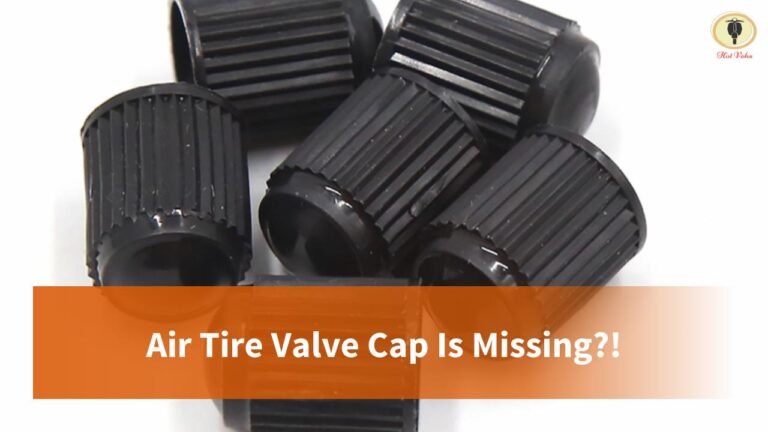A tire with its valve cap missing will not immediately lose air, but over time the slow air leak tire will lose pressure and require more fuel.
You better check regularly and make sure all your valve caps are there and fixed correctly.
If you discover a missing valve cap, you should replace the valve cap as soon as possible.
What are valve caps?
A valve cap is a small piece of metal or rubber cap found on the end of a tire’s valve. A car owner has to turn anti-clockwise to remove the cap to inflate or deflate tires when using an air hose. The rubber cap is designed to protect the tire pressure valve stem from dirt, grime, and debris.
When inflating a tire with an air hose, the car owner must put the valve cap back on after attaching the hose to let air into their vehicle. Leaving off this small screw-on metal or rubber piece will cause slow leaks in the tire over time which will bug up your wallet when you have to buy new tires every so often because of slow-leaking tires.
What is a valve core?
A tire’s valve core is the metal axis that lets air into or out of a tire.
When car owners want to add air into their tire, they must remove the valve cap, and the air hose will push down the valve core.
When should you check for missing valve caps?
The best time to check for missing valve caps is before inflating a car’s tires with an air hose.
If a car owner finds that little piece is missing from the tire, they should replace it with a new one before using an air hose to add or remove air from their vehicle.
Do car tires need valve caps?
The primary purpose of the tire valve stem caps is to stop dirt and debris from entering the tire valve stem. The valve cap is made out of rubber, plastic, or metal, which helps create a good seal around the tire stem.
The tire needs the valve stem caps because if there are any objects between the rubber and plastic parts of the valves stems, air will leak past them, causing problems for more than one part of your vehicle.
The valve cap keeps dirt and moisture out of the tire’s inner tube. When driving for an extended period of time, drivers should check their pressure regularly because heat and friction from driving cause tires to lose pressure even faster than usual. Water and other particles could enter the inner tube without the valve cap and damage it.
What is the TPMS?
TPMS stands for “Tire-Pressure Monitoring System”. This system is not a single part of your car but rather an entire system that uses several sensors to communicate information about the tires’ pressure and temperature.
The tire-pressure monitoring system sends signals from its valves to the dashboard, indicating low air pressure and overheating, as these can lead to accidents and other problems on the road.
How does a TPMS work?
The sensor system has a transmitter that picks up low-pressure levels in tires, telling it when to send a signal through the car’s diagnostic port. Once through this internal system, a message gets sent to a receiver box located under the hood, where it is sent over for display on the dashboard screen. On some vehicles, beepers are placed throughout different parts of the car.
How does TPMS warn drivers?
TPMS will either beep or show information on your vehicle’s dashboard screen when tire pressure is low, signaling you to stop at the nearest gas station to add air into tires. TPMS sensors can also tell you if your tires are overheating, which can cause problems in the future, like flat spots on tires and blowouts.
What happens when you lose TPMS tire sensor caps?
If a car owner loses their TPMS (tire-pressure monitoring system) sensor cap, it will not make their car break down or turn off on them unexpectedly. This is because there are several different types of sensors, and they all vary from one type to another as well as by car model. Some are removable, meaning you can take them out and place new ones in their place, while others must be replaced with the whole tire-pressure monitoring system.
Where is your tire pressure sensor located?
A car’s tire pressure sensors are usually attached to its rim or tucked away in its sidewall. You can find the sensors on the inside of your tire’s sidewall hidden from sight. When you add air to your tires, make sure not to hammer on any part of your car other than the metal rims because sensors are very fragile and easy to break.
Rubber vs. metal valve caps?
Both metal and rubber valve caps can fit snuggly on the end of tire valves, but it is advisable to use rubber valve caps because they are softer than metal. Metal caps can damage the valve if they are not lined up correctly.
If your vehicle has a TPMS system with metal caps, you have to use it carefully, or else you may break the TPMS system. It’s costly to replace the TPMS sensor, and it typically takes a mechanic to do the replacement.
The best option for car owners is to use rubber valve caps because they won’t break, and if you accidentally leave them off, there’s no significant risk for your TPMS system to be damaged.
A rubber valve cap is easier to remove and attach, but it can tear or break with time.
It all comes down to personal preference when choosing between metal and rubber valve caps for your rims. Some people prefer the feeling of metal under their hands, while others like the look of rubber caps better.
Either way, it is important to choose valve caps that will last for years and keep your tires in good shape.
Resources
- http://www.autos.com/car-maintenance/do-tire-valve-caps-really-help-with-pressure
- https://itstillruns.com/happen-tires-air-cover-gone-7858463.html
- https://en.wikipedia.org/wiki/Schrader_valve
- https://www.dktireservice.com/valve-caps-need-know/

